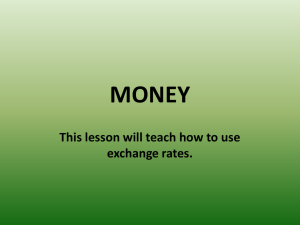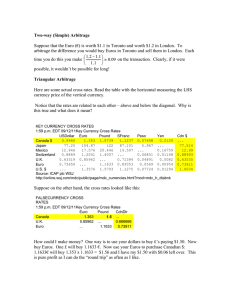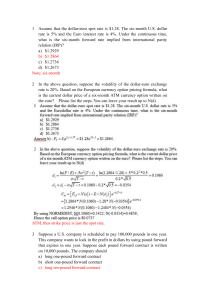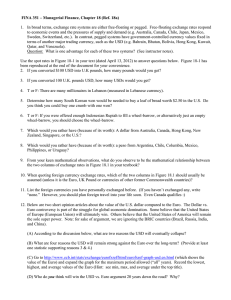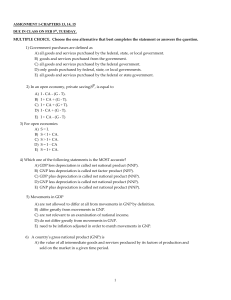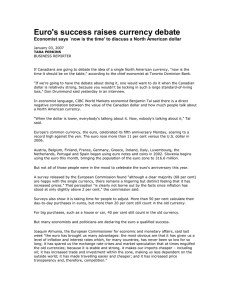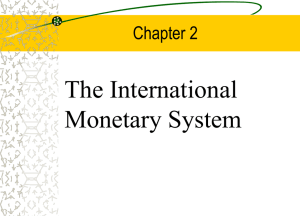SIMON FRASER UNIVERSITY Department of Economics Econ 345 Prof. Kasa
advertisement
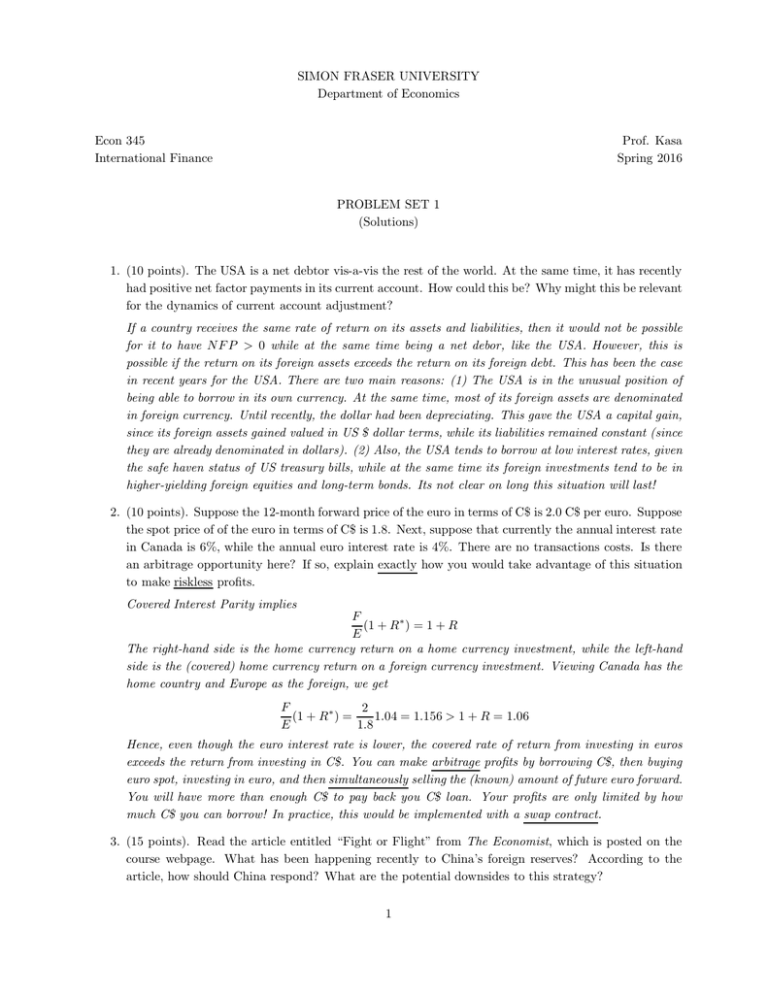
SIMON FRASER UNIVERSITY Department of Economics Econ 345 International Finance Prof. Kasa Spring 2016 PROBLEM SET 1 (Solutions) 1. (10 points). The USA is a net debtor vis-a-vis the rest of the world. At the same time, it has recently had positive net factor payments in its current account. How could this be? Why might this be relevant for the dynamics of current account adjustment? If a country receives the same rate of return on its assets and liabilities, then it would not be possible for it to have N F P > 0 while at the same time being a net debor, like the USA. However, this is possible if the return on its foreign assets exceeds the return on its foreign debt. This has been the case in recent years for the USA. There are two main reasons: (1) The USA is in the unusual position of being able to borrow in its own currency. At the same time, most of its foreign assets are denominated in foreign currency. Until recently, the dollar had been depreciating. This gave the USA a capital gain, since its foreign assets gained valued in US $ dollar terms, while its liabilities remained constant (since they are already denominated in dollars). (2) Also, the USA tends to borrow at low interest rates, given the safe haven status of US treasury bills, while at the same time its foreign investments tend to be in higher-yielding foreign equities and long-term bonds. Its not clear on long this situation will last! 2. (10 points). Suppose the 12-month forward price of the euro in terms of C$ is 2.0 C$ per euro. Suppose the spot price of of the euro in terms of C$ is 1.8. Next, suppose that currently the annual interest rate in Canada is 6%, while the annual euro interest rate is 4%. There are no transactions costs. Is there an arbitrage opportunity here? If so, explain exactly how you would take advantage of this situation to make riskless profits. Covered Interest Parity implies F (1 + R∗ ) = 1 + R E The right-hand side is the home currency return on a home currency investment, while the left-hand side is the (covered) home currency return on a foreign currency investment. Viewing Canada has the home country and Europe as the foreign, we get F 2 (1 + R∗ ) = 1.04 = 1.156 > 1 + R = 1.06 E 1.8 Hence, even though the euro interest rate is lower, the covered rate of return from investing in euros exceeds the return from investing in C$. You can make arbitrage profits by borrowing C$, then buying euro spot, investing in euro, and then simultaneously selling the (known) amount of future euro forward. You will have more than enough C$ to pay back you C$ loan. Your profits are only limited by how much C$ you can borrow! In practice, this would be implemented with a swap contract. 3. (15 points). Read the article entitled “Fight or Flight” from The Economist, which is posted on the course webpage. What has been happening recently to China’s foreign reserves? According to the article, how should China respond? What are the potential downsides to this strategy? 1 The article shows that China’s foreign reserves have been falling recently. Estimates suggest that reserves declined by nearly $700 billion during past year. Although its stock of foreign assets is quite large (about $ 4-5 trillion), this cannot go on forever. In particular, reserve depletion is nonlinear, and tends to accelerate once investors suspect the central bank will run out. China has two basic options: (1) Allow its currency to float. Outflows will produce a currency depreciation, which will then tend to reduce the incentive for further outflows (which tend to be driven by expectations of possible future depreciations), or (2) Clamp down on capital controls, by making it harder to take money out of the country. Part of the reason China has experienced recent capital outflows is that the government has taken steps to ease its capital controls. The article advocates stricter capital controls, and cites Malaysia as a supportive case study. However, China is not Malaysia. China has a long-term goal of internationalizing the RMB, and re-imposing capital controls would likely conflict with this goal. It will be interesting to see what they do! 4. (15 points). The Canadian dollar has been depreciating recently. At the same time, the Bank of Canada has been cutting its interest rate, while the US Fed has been raising its interest rate. Given this, under what conditions could Uncovered Interest Parity help explain the recent weakness of the Canadian dollar. Use graphs to illustrate your answer. This question is straight from the textbook and lecture slides (see, e.g., lecture 2 (Part B) pgs. 5-6). Of course, the C$ seems to be primarily driven by the price of oil these days (remember BalassaSamuelson!), but US and Canadian monetary policies have likely contributed to the recent weakness as well. In particular, a decline in domestic interest rates shifts the vertical R curve left. At the same time, rising US interest rates shift the R∗ + (E e − E)/E curve up. Both shifts produce a depreciation of the C$. 2




